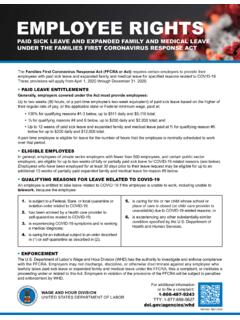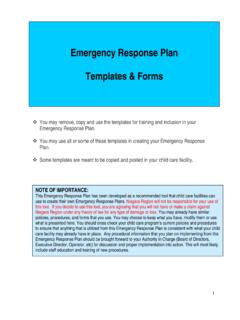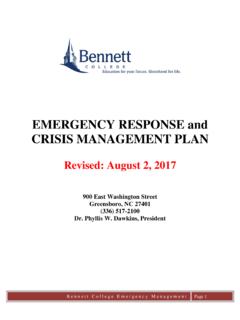Transcription of Emergency Preparedness and Response in the School Setting
1 Emergency Preparedness and Response in the School Setting The Role of the School Nurse Position Statement SUMMARY It is the position of the National Association of School Nurses (NASN) that the registered professional School nurse (hereinafter referred to as School nurse) provides leadership in all phases of Emergency Preparedness and Response . School nurses are a vital part of the School team responsible for developing Emergency Response procedures for the School Setting using an all hazards approach. The School nurse is often the first health professional who responds to an Emergency . The School nurse has the education and knowledge to identify emergent situations, manage the Emergency until relieved by Emergency medical services (EMS) personnel, communicate the assessment and interventions to EMS personnel, and follow up with the health care provider.
2 BACKGROUND Each School day, families entrust our nation s schools to provide safe and healthy learning environments for approximately 55 million elementary and secondary School students in public and nonpublic schools (U. S. Department of Education [USDE], 2012). Families and communities expect that schools will keep children safe from threats ( , human caused emergencies such as crime and violence) and hazards ( , natural disasters, disease outbreaks, and accidents) (USDE, 2013). There is a fundamental link between day to day Emergency readiness and disaster Preparedness . Schools that are well prepared for an individual Emergency involving a student or staff member are more likely to be prepared for complex events such as community disasters (AAP, 2008). School nurses respond to emergencies and disasters that can range from one student or adult injured to the mass illness situations observed with the H1 N1 influenza pandemic (Pappas, 2011).
3 An Emergency is a dangerous event normally managed at the local level (Doyle, 2011). Disasters are distinguished from emergencies by the greater level of Response required. A disaster is a dangerous event that causes a significant human and economic loss, and demands a crisis Response beyond the scope of local and state resources (Federal Emergency Management Agency [FEMA], 2011; Doyle, 2013). Whether for an Emergency or disaster, Preparedness is essential to ensure an effective Response (Doyle, 2011). Planning for health related emergencies involves developing Emergency plans for students with known health related conditions, and utilizing first aid skills to assess and respond to other unanticipated medical emergencies. The types of Emergency events for which the School nurse must be prepared to respond include: Student, staff and visitor health related emergencies, due to injury or illness.
4 Large numbers of individuals in casualty incidents, such as the collapse of bleachers, exposure to toxic gas, or a School shooting (Doyle, 2013). Weather related emergencies ( hurricanes, tornadoes, tsunamis and flooding, snow and ice storms). Hazards such as explosions and fires, physical plant, technological hazards, or nuclear meltdowns that may cause damage in the School and result in physical injuries, or loss of life. For larger scale emergencies and disasters, the National Response Framework (NRF) offers guiding principles that enable all Response partners to prepare for and provide a unified national Response to disasters and emergencies from the smallest incident to the largest catastrophe (FEMA, 2013). The term Response as defined by NRF includes taking immediate action to save lives, protect property and the environment, and meet basic human needs.
5 Response also includes the execution of Emergency plans and actions to support short term recovery. The NRF also describes how agencies, such as schools, can work together with communities, tribes, states, the federal government, and private partners (Doyle, 2011). Two national Response models serve as the framework for local policy and Response plans. The National Incident Management System (NIMS) is a comprehensive national design for approaching incident management. NIMS provides the template for management of the incident, while the NRF provides the structure and mechanisms for national level policy for incident management (FEMA, 2011). One component of the NIMS is the Incident Command system (ICS), which provides a standardized approach for incident management, regardless of cause, size, location, or complexity. By using ICS during an incident, schools will be able to more effectively work with the responders in their communities (USDE, 2013).
6 To maximize success, effective management of School emergencies requires training, preparation and planning for best practices (RWJ, 2012). RATIONALE Schools should be responsible for anticipating and preparing to respond to a variety of emergencies (Doyle, 2013). School nurses, by virtue of their education, are experts in the nursing process, which includes assessment, planning, implementation and evaluation (Doyle, 2011). During emergencies, these steps closely parallel the phases of Emergency management, which include prevention/mitigation, Preparedness , Response , and recovery. The School nurse, as a leader, is in the unique position to provide continuous integration, coordination, and training of all School and community members within the framework of the School s Emergency management plan. The role of the School nurse within the four identified phases of Emergency management planning includes the following: Prevention/ Mitigation: School nurses should participate in an ongoing assessment to identify hazards from all possible sources and to reduce the potential for an Emergency to occur.
7 Examples include educating students and staff about recognizing and reporting suspicious behaviors and persons, implementing and maintaining an effective immunization program for students and staff, improving security measures to control access to School facilities and using metal detectors at entry points if appropriate (Doyle, 2011). Preparedness : School nurse participation on community wide planning groups is helpful in the facilitation of a rapid, coordinated, effective Emergency Response within the framework of the ICS. This includes establishing standard Emergency Response plans and practicing skills, drills and other exercises to evaluate the Response capabilities of a School , as well as the effectiveness of the plan ( , medical Emergency , evacuation, shelter in place, lock down, and intruder). Specifically, the School nurse can be instrumental in identifying unique Emergency Preparedness needs for children with special health care needs, as well as specific equipment and supplies needed to respond, and to assess for and provide first aid.
8 Response : The School nurse is knowledgeable about her or his role in responding to an Emergency , which may include triage, training of first aid Response teams, and direct physical and mental health care for all victims of an Emergency , including linking them to medical and public health resources. The School nurse also serves a vital role in reuniting families during and after a crisis (RWJ, 2012). NASN s School Emergency Triage Training (SETT) program, (NASN, 2012) provides School nurses with the knowledge, skills and resources to perform as leaders of First Aid teams in Response to mass casualty events occurring in the School Setting . Recovery: After a disaster, the School nurse assists students, parents, and School personnel, providing direct support and serving as the liaison between community resources and those in need. This includes both short and long term recovery, and may include maintenance of student and staff health status, as well as mental health issues and psychological Response .
9 Children with Special Health Needs Schools are responsible for the Emergency management planning and Response efforts to assist students with special health care needs. This includes conducting an evaluation, providing housing, and caring for these students during an Emergency event (Robert Wood Johnson [RWJ], 2012). If students are required to be sheltered in School for extended periods, the School nurse plans and prepares to support and care for children with chronic health conditions, including diabetes, asthma, and allergies/anaphylaxis. These plans may include: Healthcare provider orders for 72 hour lockdown or disaster. A system for retrieving and transporting medications to areas of lockdown or evacuation. Provision of necessary supplies and food in the classroom or carried with the child or teacher in an evacuation or a 3 day supply in case of a lock down.
10 Education of all staff members/substitutes responsible for the child with a special health needs during an Emergency . An alarm system for students with auditory and/or visual needs. Back up power source for specialized equipment. Emergency evacuation plan for students with physical, mental or communication limitations ( visually and/or hearing impaired, students with autism, and English as a second language students). Emergency Equipment A primary role of the School nurse is to ensure a system is in place to provide triage and immediate first aid care to ill and injured students, staff and community volunteers. This is accomplished by the School nurse, or through his/her direction of others (Doyle, 2011). The availability of essential Emergency supplies is an integral component of being able to render appropriate on site care and manage the Emergency condition (Doyle, 2013).















